Caldwell 105
This colorful cluster was discovered by French astronomer Nicolas-Louis de Lacaille in 1751 during a journey to South Africa.
Distance
22,000 light-years
Apparent Magnitude
7.0
constellation
Musca
object type
Globular Cluster

This swarm of stars is Caldwell 105, a densely packed stellar collection known as a globular cluster. These compact clutches typically contain hundreds of thousands of stars, all bound together by their mutual gravity. The stars pictured here are very old, some of the first inhabitants of the Milky Way, born at the time of our galaxy’s formation. Scientists target globular clusters for study because of their potential to help unveil information about the formation and evolution of galaxies.
The subtle color differences peppered across this Hubble image, which was taken in visible and infrared light with the Advanced Camera for Surveys, actually reveal a lot about the stars that inhabit the cluster. That’s because a star’s color reveals its temperature. Our Sun produces more yellow light than any other color because its surface temperature is about 10,000° Fahrenheit. If the Sun’s surface were cooler — say 5,000° F — it would look reddish; if it were hotter — say 20,000° F — it would look blue.
It takes a lot of nuclear fuel to power hotter stars, so a higher temperature means a larger mass. More massive stars burn through their nuclear fuel faster, so they only grace the skies for a relatively short time. Since the stars in Caldwell 105 tend to have yellowish-white tones, we know that they are old, cool, and not very massive.
Located about 22,000 light-years away, Caldwell 105 is one of the Milky Way’s 150 (or more) globular clusters. It is located in the southern constellation Musca and is best seen in the autumn from the Southern Hemisphere. (Observers in the Northern Hemisphere would need to be located near the equator to see it, low in the southern sky during the spring.) The cluster was discovered by French astronomer Nicolas-Louis de Lacaille in 1751 during a journey to South Africa and was subsequently catalogued as NGC 4833. With a magnitude of 7, the cluster is unlikely to dazzle except in large telescopes.
For more information about Hubble’s observations of Caldwell 105, see:
A Sky Full of Stars

Glossary
Globular Cluster - A spherical group of stars that are gravitationally bound to each other, with most of the stars concentrated at the cluster’s center.
Magnitude - The brightness of an astronomical object, represented by a number; bright objects have low numbers on the magnitude scale, while dim objects have high numbers.
Explore Hubble's Caldwell Catalog
The following pages contain some of Hubble’s best images of the Caldwell objects.

Caldwell 1
Also known as NGC 188, this group of stars formed from a large cloud of gas making the stars roughly…

Caldwell 2
This shell of gas is expanding outward, away from the dying star within.

Caldwell 3
This barred spiral galaxy was first spotted by British astronomer William Herschel in April 1793 in the constellation Draco.




